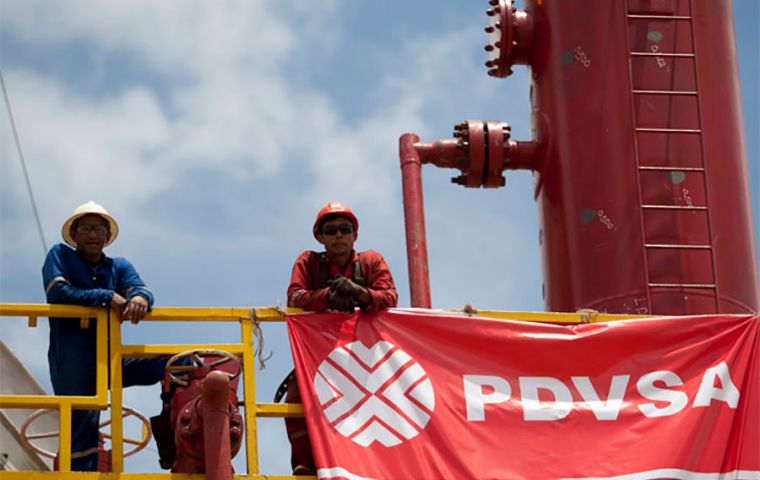MercoPress. South Atlantic News Agency
With help from Iran and China, Venezuela recovering part of its production
 According to Lloyds List Intelligence, in 2020 around 150 ships transported Venezuelan oil to Asia, mainly via Malaysia to be moved to China and Indonesia
According to Lloyds List Intelligence, in 2020 around 150 ships transported Venezuelan oil to Asia, mainly via Malaysia to be moved to China and Indonesia By Felicity Bradstock for Oilprice.com – Venezuela appears to be following in Iran’s footsteps by starting to ignore U.S. sanctions on its oil industry to once again develop its substantial crude reserves. After years of stalling and losing out on international investment as well as vital revenues, Venezuela looks to be set to increase its oil production, fostering relationships with key export markets that are willing to risk U.S. retaliation to the move.
Over the last few weeks, Iran has built upon the foundations it made in 2021 to re-establish its international position as a major oil producer. This move saw Iran develop key partnerships with China and Russia in a bid to overcome U.S. sanctions in order to increase its oil production and recommence exports. Now it seems that Venezuela is taking similar action, finding ways to overcome its oil sanctions to help support its weakening economy.
Venezuela’s ruling political power, the Socialists United Party (PSUV), is working with China and Indonesia to kick-start the country’s oil industry after years of halted operations. But despite the fact that oil prices are rising around the globe as demand is continuing to rise, the U.S. is unlikely to drop its sanctions on Venezuela while the current political power maintains its rule, even with the potential for oil prices to improve upon an influx of Venezuelan crude.
According to Lloyds List Intelligence, in 2020 around 150 ships transported Venezuelan oil to Asia, mainly via Malaysia to be moved to China and Indonesia. With Asian oil demand expected to increase by 1,7 million bpd in 2022, the region is not so picky about where it comes from. If it can get lower cost and reliable oil imports from Iran or Venezuela it will.
China is thought to have purchased a total of 324 million barrels from Iran and Venezuela in 2021, an increase of 53% on 2020, the highest quantity since 2018. It has achieved this level of imports through several means. Firstly, sanctioned oil often arrives on old ships that are set for the scrap-yard. Secondly, oil comes in tankers that have gone dark – their transponders are turned off to avoid detection. And, thirdly, oil cargoes are transferred at sea from tanker to tanker to avoid knowledge of where the oil came from. Much of the oil is rebranded to make international authorities believe it came from Oman and Malaysia, with imports from these countries increasing significantly since 2020.
China seems largely unphased by the potential repercussions of buying sanctioned oil. Private Chinese refiners, AKA teapots, are the most common purchasers of Iranian and Venezuelan crude. They benefit from the lower prices and availability since U.S. allies in Asia, such as Japan and South Korea, stopped purchasing from the sanctioned states.
In 2021, Venezuela is thought to have almost doubled its oil output from the previous year. This comes as state-owned Petroleos de Venezuela (PDVSA) gained the support of several small drilling companies thanks to rolling over their debts. In addition, the firm imported a dilutant from Iran to refine its extra-heavy crude, after initially worrying about shortages of the dilutant. Output totaled around 824,000 bpd in November, much higher than that of previous months. And at the end of 2021, Venezuela reached 1 million bpd, marking a huge turnaround, although nowhere near its 3.2 bpd peak in 1999.
But Francisco Monaldi, director of the Latin American Energy Program at Rice University’s Baker Institute in Houston, believes there is a cap on PDVSA’s production potential. The lack of foreign investment and drilling equipment in the country, largely in relation to ongoing U.S. sanctions, means that the firm has limited oil output capabilities. ”Base production in 2021 was way below PDVSA’s production capacity.” And “We are reaching that capacity now. To see an output increase during 2022, investment in new wells and upgrading infrastructure is needed,” he stated.
Much of this success is linked with the socialist country’s recent partnership with Iran. The dilutants, such as naphtha, purchased from Iran are essential to reducing the viscosity of the Venezuelan crude in the Orinoco heavy-oil belt. The thinners are transported from Iran to Venezuela via complex routes to avoid U.S. detection. Juan Fernández, former Executive Director of Planning at PDVSA, explains, “Oil production estimates for the belt currently add up to 450,000 to 500,000 barrels a day and that is due mainly to Iran’s help.”
Following in Iran’s footsteps, Venezuela is once again profiting from its long-established oil industry. But while its recent oil output looks promising, Venezuela still relies on the U.S. dropping its sanctions on the country’s oil industry to gain greater foreign investment and maintain its currently high oil output.




Top Comments
Disclaimer & comment rulesCommenting for this story is now closed.
If you have a Facebook account, become a fan and comment on our Facebook Page!